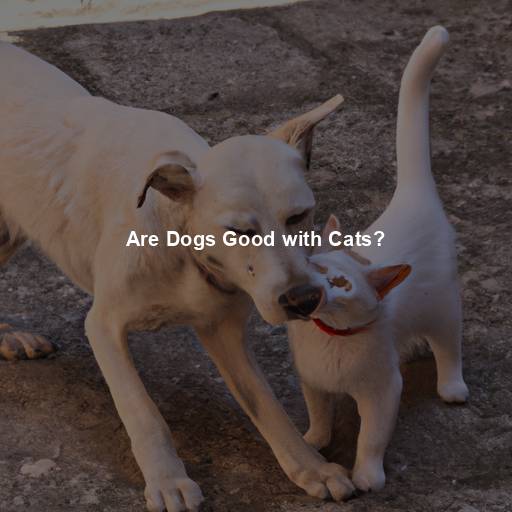Are Dogs Good with Cats?
Last Updated on October 18, 2023 by Evan
Contents [hide]
Tip 2: Separate s
When it comes to the intriguing dance of introducing two furry friends, caution is key. Begin by enforcing a temporary division, like a magician’s trick, using baby gates or separate chambers. But fear not, for the jigsaw pieces shall start falling into place as their curious noses dance around scents exchanged through the swapping of bedding and sniffable toys. This delicate tango of familiarization will set the stage for a harmonious encounter, reducing the dicey odds of an initial clash.
Tip 3: Supervised Interactions
Once both animals have become comfortable with each other’s scents, it is time to move on to supervised interactions. This can be done by allowing them to see each other through a barrier or by holding the dog on a leash while the cat roams freely. Observe their body language and behavior closely during these interactions. If any signs of stress or aggression arise, separate them and try again later.
Tip 4: Positive Reinforcement
Encouraging our furry companions to exhibit favorable conduct can be quite the labor of love. By utilizing positive reinforcement techniques, we can effectively mold the behaviors of both our feline and canine friends. Lavish them with delectable treats and heartfelt praises when they demonstrate calm and amiable interactions, allowing them to establish positive connections and keeping them motivated to sustain these admirable manners. It is paramount to steer clear of reprimanding or berating our beloved companions throughout the process of integration, as it can potentially cultivate an adverse atmosphere and impede any headway we may strive for.
Tip 5: Training and Socialization
When it comes to our beloved furry friends, we all know that training and socialization are key. Dogs, with their playful nature, can greatly benefit from obedience training, mastering those basic commands, and sharpening their impulse control skills. But guess what? Cats, too, can be successfully trained to a certain extent, especially when it comes to understanding the art of scratching post etiquette and following those oh-so-important cues.
Tip 6: Providing Individual Spaces
Creating a harmonious cohabitation between our canine and feline companions necessitates embracing the concept of spatial autonomy. Allocating distinct areas for both the dog and the cat is imperative, guaranteeing that each creature has exclusive access to their own provisions – be it food and water bowls, litter boxes, plush resting spots, or captivating toys. By designating individual territories and resources, we effectively diminish the origins of potential discord derived from guarding assets or asserting territorial claims. Additionally, incorporating vertical sanctuaries, such as enchanting cat trees or inviting shelves, offers our feline friends an invaluable haven wherein they can find solace and seek refuge when the need arises.
Tip 7: Seek Professional Help if Needed
If you are struggling with integrating your dog and cat or if there are persistent compatibility issues, do not hesitate to seek professional help. An animal behaviorist or a certified dog trainer can provide guidance and develop a tailored plan to address any specific challenges you may be facing. They can assess the behavior of both animals and provide valuable insights and strategies for improving their relationship.
The Beauty of Canine-Feline Relationships
Bringing together two different species under one roof may seem like an arduous task, filled with uncertainties and challenges. However, the outcome of a harmonious bond between a dog and a cat can truly be priceless. Witnessing the companionship, solace, and delightful antics that these furry creatures can bestow upon each other is a reward like no other. Through careful consideration of their specific requirements, creating a secure and stimulating space, and employing positive reinforcement strategies, pet guardians can navigate the intricate path to fostering a long-lasting friendship between their beloved pets.
In the enchanting world of pets, there exists a tapestry of individuality where dogs and cats dance to the rhythm of their own paws. As we embark on the journey of blending their furry lives, we must embrace the enigma that lies within their intricate compatibility codes. With patience as our guide and an open heart as our compass, we can navigate the labyrinth of their unique needs and curate a harmonious symphony of meows and barks, filling our abode with a kaleidoscope of unconditional love and laughter.
FAQs: Are Dogs Good with Cats?
Can dogs and cats get along?
Without a doubt, canines and felines have the potential to form a harmonious bond in their furry realm. Though, at first encounter, it’s not uncommon for a mix of uncertainty and wariness to emanate from both parties. However, with a delicate balance of introductions, social mingling, and well-coordinated guidance, a beautiful friendship might start blooming. Keep in mind, each animal possesses their distinct personality, past escapades, and the influence of their human companions, making the future of their relationship a delightful enigma to unravel.
How can I introduce my dog and cat?
Introducing two furry friends, such as a dog and cat, can be a thrilling yet perplexing journey. One cannot simply throw them into the same room and expect an instant connection. Oh no, dear pet enthusiasts, the key lies in the art of gradual introduction and controlled exploration. At the outset, let their curious noses exchange scents through closed doors or the omnipotent baby gate. Think of it as a tantalizing tease, building familiarity sans direct contact. As you progress, overseeing their face-to-face rendezvous on leashes and harnesses becomes paramount, ensuring an extra safety net. Reward their positive behavior with tasty treats, for every accomplishment deserves recognition. While time is undoubtedly a confounding factor, trust in the process, dear readers, for proper introductions hold the power to transform these four-legged fellows into lifelong companions, bound by an unbreakable bond.
What should I do if my dog and cat do not get along?
It’s a conundrum we all dread: the never-ending feud between our furry companions. But fear not, for there is light at the end of this perplexing tunnel. Seeking the expertise of a certified animal behaviorist or a wise trainer may hold the key to unraveling the complexity of their relationship. Creating separate havens for each pet, from designated feeding zones to supervised play sessions, can provide solace amidst the chaos, ensuring that their individual needs are met while thwarting potential skirmishes.
Can some dog breeds be better with cats than others?
While it’s true that specific dog breeds have a reputation for getting along well with cats, it’s important to recognize that temperament and socialization are key factors in fostering peaceful coexistence. Alongside breed considerations, individual personality traits, energy levels, and past experiences should be taken into account when determining compatibility. Golden Retrievers, Labrador Retrievers, Beagles, Bichon Frises, and Cavalier King Charles Spaniels are among the dog breeds often lauded for their cat-friendly nature. However, each dog should be evaluated on a case-by-case basis to ensure a harmonious furry companionship.
How can I ensure a safe and harmonious relationship between my dog and cat?
Creating an environment of peaceful coexistence between your canine and feline companions may seem like a daunting task, but fear not! By incorporating these valuable insights, you can pave the way for a blissful and amicable bond. Embrace the unpredictability and diversity of their personalities, while being mindful of territorial boundaries and individual preferences. Remember, building a solid foundation of trust and gradual introductions will ultimately lead to a harmonious and well-balanced relationship, leaving you in awe of their incredible ability to navigate the complex dynamics of the animal kingdom.
- Provide separate spaces for each pet where they can retreat and feel safe.
- Gradually introduce them, using positive reinforcement and supervised interactions.
- Never force them to interact if they seem fearful or stressed.
- Train your dog to respond to basic commands and reward them for calm behavior around the cat.
- Never leave them unsupervised until you are confident in their ability to coexist peacefully.
If you find yourself grappling with difficulties and feeling overwhelmed, don’t hesitate to reach out to qualified professionals who can provide the support and guidance you may need. It’s imperative to prioritize your well-being and recognize that seeking professional help is a strength, not a weakness. Experts in various fields can offer valuable insights and strategies to help you navigate life’s challenges with courage and resilience. Remember, you are not alone, and there are resources available to assist you in your journey towards personal growth and emotional well-being.
Remember, each pet is an individual, and it may take time and effort to establish a positive relationship between your dog and cat. However, with patience, consistency, and proper guidance, many dogs and cats can become great friends and enrich each other’s lives.






